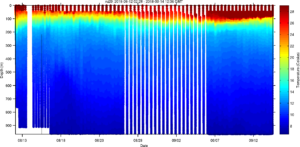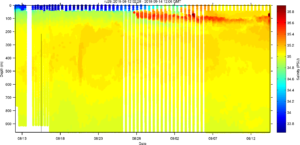RU29 flew straight east over Friday and Saturday until it passed north of the seamount. With the strong northward currents, much of RU29’s flight has been eastward so far. Early Sunday morning the waypoint was changed back to Southeast, based on the depth average currents plots from the U.S. and European models. We are currently heading in the direction shown by the orange line. And we again are in international waters. The yellow lines mark the EEZ limit for Brazil. Hopefully the next EEZ we enter is South Africa’s.

Zooming out to the long view, below is the South Atlantic Basin. RU29’s trip around the basin is divided into 3 legs. Leg 1 (blue) was from Cape Town, South Africa to Ascension Island in 2013. Leg 2 (green) was Ascension to Ubatuba, Brazil in 2014. Leg 3 (red) is one potential flightpath back to Cape Town via Tristan da Cunha. We’ll keep this red line up as a reference. We are currently flying along the orange line. Total great circle distance to Cape Town from the present location is 5,600 km. Assuming a strong speed of 25 km/day, its about 7.5 months to cover this distance. Again assuming all goes well, that gets us to Cape Town about March 2016 at the earliest. We are leaving tropical Brazil during the southern hemisphere winter. As we fly southeast, we will transition into southern hemisphere summer, hopefully arriving Cape Town as their summer is ending.







